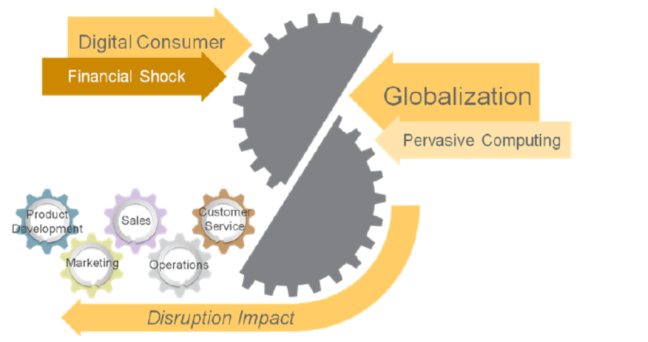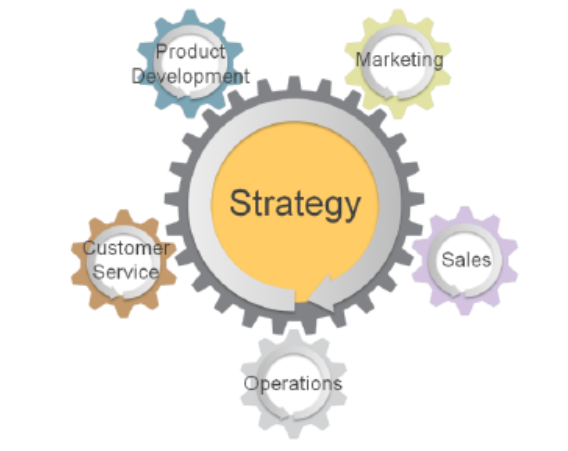Think AND Do…The Need for Continuous Strategy
Overview
This point of view will explore the concept of Continuous Strategy and how the concept has graduated from academic debate to a pressing business need.

To fully appreciate the shift that is now required, one must understand the strategic planning process as it has existed in boardrooms around the globe for more than a hundred years. This established method of a period of planning (thinking) followed by a longer period of executing on those plans (doing) will be placed in the context of sweeping changes underway in the 21st century. The bottom line is this: the global business environment is in a state of flux. A confluence of economic and technology forces are creating an unprecedented degree of operating uncertainty for businesses. Whipsawed by the volatility of events in recent years, many organizations have come to realize that the strategic planning process is ill equipped to help them manage through and thrive in the conditions of today’s markets.
The new rules of the game put a premium on staying nimble and acting with speed at all levels of the organization, being able to spot change before it happens and then optimizing the levers of execution to profit from disruption. Organizations that are able to do this well have adopted a new model for planning called Continuous Strategy: they learn by doing, adjusting the strategy as demanded by risks and opportunities as they emerge at every level of the organization, innovating as they go, hoping to fail fast and win big.
Where have we been?

The term strategic management has replaced corporate planning in recent years; however, the process has not changed significantly. Companies still align their strategy to the fiscal calendar instead of market events, and they usually adhere to three core principles:
1. Set goals based on forecasts and noteworthy market trends: The strategy should demonstrate rigorous quantitative analysis and awareness of all high-level market forces that have potential to impact the business model.
2. Document the plan collaboratively and comprehensively: The strategy should be created based on group-think with ample time for in-depth discussion and executive approval to ensure stakeholder buy-in and accountability. It also should be documented diligently with clear, actionable targets.
3. Have a high degree of confidence and certainty in the final strategy: Once the strategy has been finalized, it should not be challenged internally. Employees should align with the strategy and prioritize their efforts in order to meet the company’s targets. Proposing any substantive changes is not advisable unless absolutely necessary due to extreme circumstances.
This traditional approach to strategic planning assumes that forecasts are accurate, market trends evolve predictably, and circumstances that would invalidate the strategy are rare. Large companies typically set their strategy annually, establishing goals, initiatives, resource plans, and budgets during the same period every year.

Each sweeping strategic goal is supported by three to six high-level tactics; and champions or advocates are assigned to tactic to ensure that it gains momentum in the organization. Quarterly reviews are conducted to take stock of results and lagging indicators.
Most large corporations build the strategic planning process around a structured exercise that flows linearly from a fact-base to imperatives that set direction for the business over the coming period:
1. Review the business context, past initiatives, results, and lessons learned
2. Gather input from key stakeholders to generate assumptions on the market, customers, product priorities, expectations for growth, and the costs to service or acquire new revenues
3. Align the aspirations of the operating businesses with the organization’s strategic goals over a defined time horizon, typically for one-to-two years and in some cases five
4. Build the business case to justify the financial and strategic value of alternative investments and prioritize for the organization
5. Suggest and execute changes to business, operational, and organizational models
Substantial time and resources are consumed to ensure that the planning process is executed with rigor. And more often than not, it is not revisited until the start of the next calendar year’s planning cycle.
And yet, the return on this effort is often weak. A study conducted by KPMG found that 85% of corporate strategies fail to deliver their expected impact. In our view, the source of this failure lies in the rigidity of the process itself, relying as it does on the calendar to set the agenda along with assumptions and beliefs about the market that, in a rapidly changing business environment, are dated before the executive suite gives its signoff on the plan.
What is happening now?
Consider the economic upheaval and Financial Shock of recent years. Past recessions have played out with a similar pattern of decline and recovery, albeit with varying slopes on both ends of the cycle. However, this time things are different. Four years after global economies teetered on the brink of collapse, the worst credit crisis in more than half a century still cripples the developed markets. Some liken the stagnation gripping the US to Japan’s “lost decade.” Across the Atlantic, the Euro-zone stands on the precipice of a double-dip under the weight of massive sovereign debt. And in the developing regions, a deceleration of growth poses the risk of fiscal uncertainty, which could tamp down prospects for expansion in what had been a safe haven for business. A rocky recovery coupled with sweeping regulatory changes and massive public intervention in the private sector are, collectively, upsetting business norms and fueling market uncertainty.
As the financial crisis has demonstrated the net effects of Globalization – fewer barriers to trade, communication, and cultural exchange – do not always translate into wealth creation. The dependencies between markets (e.g. China on the US for exports, the US and Europe on China for bond purchases) have made it impossible for economies and businesses to take shelter when trading partners falter. This inherently adds more risk and uncertainty to the business environment, which underscores the need for organizations to continuously validate the strategic imperatives of the business.
While markets roil in search of equilibrium, digital technologies have made global economies ever more interconnected, raising the specter for big wins and big losses. The Internet, as we’ve seen, has created unprecedented access to new Digital Consumers and markets, while at the same time has dramatically lowered entry barriers to emerging competitors. Likewise, the proliferation of mobile devices is expanding points-of-sale and advertising channels for all kinds of businesses, but at the cost of fragmenting audiences and user experiences. In a similar vein, we’ve observed how social media is raising the potential for word-of-mouth marketing and two-way dialogues with customers. When it works well, new products and brands can build momentum overnight. When it fails, the pain can be immediate and amplified globally across the chatter of social networks.
An interconnected digital world is giving rise to the notion of Pervasive Computing, or the seamless integration of communications and computing with end-users. By turning nearly everything into a computing device, pervasive computing is making it an imperative for organizations to consider new models for reaching end users. Users in turn are accessing content and applications through a multitude of channels, resulting in an exponential growth of data that need to be constantly monitored and analyzed. Pervasive computing can have a profound impact on competitive strategy for those organizations that can manage through the complexity and get it right.

The disruptive impact of these forces is being felt across every part of the enterprise (see Figure 2 above), compelling the various core business functions into accelerated motion. Although specific effects will vary across functions, one common effect is shared: cycle times are being slashed. Product development groups are being challenged to become responsive. Marketing faces a reality where campaign messaging needs adjustment in days, not months. Sales departments struggle with playbooks never designed to meet customer demands that can change overnight. Operations face heightened pressures to be agile and modular in response to fluid circumstances, while customer service areas struggle to maintain customer intimacy and service levels through ever-changing segment priorities.
What do we need to do?
Navigating the uncertainties of the current financial crisis, digital transformation, globalization, and pervasive computing requires a break with convention. Firms need to adopt a capability that allows them to act with speed and agility even at the strategic level, going where the growth is before their peers. It means thinking and doing in tandem, refreshing core assumptions and tactics in real-time, and pulling multiple levers at once to truly optimize execution across the enterprise. In the simplest terms, if all the components of a business are in constant motion, and the strategy is central to the company’s survival, the strategy itself must be capable of continuous adaptation.

Organizations that embrace continuous strategy are constantly evaluating their performance and making strategic shifts to account for new and better information. They learn by doing, adjusting the strategy as demanded by risks and opportunities as they emerge at every level of the organization. By staying nimble, these firms gain the capacity to fail “fast and cheap”, allowing for greater innovation at a lower ongoing cost in time and resources.
- Organizations that make continuous strategy their credo reap additional benefits, too:
- Actively narrow the gap between strategy and execution
- Orchestrate tactics in tandem while operating within the constraints of the strategy
- Widen the range of options available to the business and the ability to act with urgency
- Acquire the capacity to flexibly scale up or down participation in global markets
- Sharpen decision making with a deeper, transparent line-of-sight into drivers of performance
- Meet customer requirements with greater precision and skill
Putting continuous strategy into practice requires a feedback loop of information that the business can absorb and act upon in near real time. This requires a data model and set of practices for collecting, synthesizing, and sharing insights into aspects of the business, its customers, and partners that have the greatest bearing on business opportunities and risk. Of equal importance are the measures and metrics used to extract what’s important and how they are delivered to enable easy consumption and rapid decision making.
Armed with better information, governance models become essential to how organizations protect the integrity and confidentiality of data circulating throughout the business. Policies and controls have a role, too, in clarifying how and when line managers can take action on information for the benefit of their operations and the organization at large. And finally, a capacity to learn and embrace complexity and change is what distinguishes organizations that live by the maxim of continuous strategy. It’s a cultural choice that sets them apart from their peers who look to the past and refuse to adapt.
Conclusion
Although the concept of Continuous Strategy may be new for some, the need for this capability has been steadily increasing over the past decade. Unfortunately, the early responses to converging disruptive forces have happened mostly in tactical pockets around the organization, much like troops in the trenches will be the first to adapt to a change in battle. However, the sea of change is now so pervasive, companies that expect to survive (much less thrive) need to adapt across all levels on a continuous basis, even at the strategic level. Continuous strategy is not constantly planning while doing; rather, it is having the capability to make strategic adjustments in a rapid manner when warranted by changing circumstances. Actively monitoring trigger events coupled with predefined calls to action enable companies to efficiently handle strategic shifts. More importantly, it allows a company to fully align with the realities of today’s unpredictable business environment, from the top of the organization to the bottom.
47.567442
7.597551